What do you choose for the top string on your soprano, concert, or tenor Ukulele? Low G vs. High G? Possibly one of the most hotly debated topics in all of Ukuleledom.
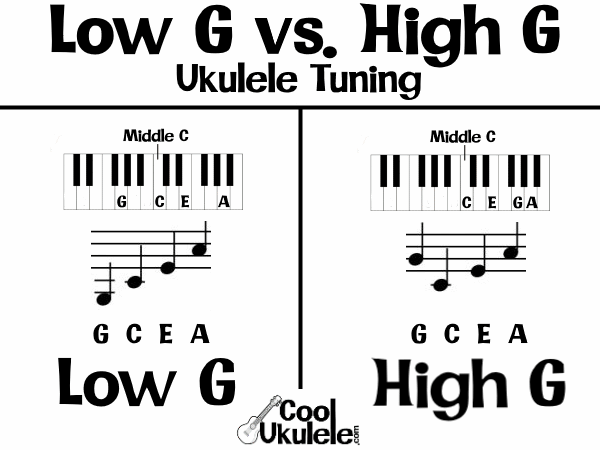
What are the Main Differences Between Low G and High G Ukulele Tuning?
The two most significant differences between Low G and High G ukulele tuning are the sound and range of notes. Sound-wise, low-G tuning is generally deeper and fuller; while high-G is brighter and more typically ukulele sounding. Range-wise, Low-G tuning provides an extra 5 notes which are advantageous for certain playing styles, while other play styles are more suited to High-G Tuning.
Now let’s attempt to examine all the possible reasons someone could have for choosing one tuning system over the other.
So strap in and prepare yourself as we try to come to the final conclusion on this timeless tuning system tango!

Contents
- What are the Main Differences Between Low G and High G Ukulele Tuning?
- What is High-G Ukulele Tuning?
- What is Low-G Ukulele Tuning?
- Low G vs. High G Ukulele: Sound Comparison
- What are the Frequencies Used in High G and Low G Ukulele Tuning?
- What is the Range Difference Between High-G and Low-G Tuning?
- How Do Chord Shapes in Low G Tuning Compare to Those in High G?
- High G vs. Low G Fretboard Notes Comparison
- Playing Style Differences
- Availability of Low-G and High-G String Sets and Ukuleles
- Low-G vs. High-G Tuning: Conclusion
- The Old Low G vs. High G Ukulele Tuning Article
What is High-G Ukulele Tuning?
Traditionally, soprano, concert and tenor ukuleles are tuned with high-G (or re-entrant) tuning.
This means the top string of the ukulele is tuned higher than the string below it (the 3rd or C string). The C string is tuned to Middle C, and the other two strings are tuned to E and A above Middle C.
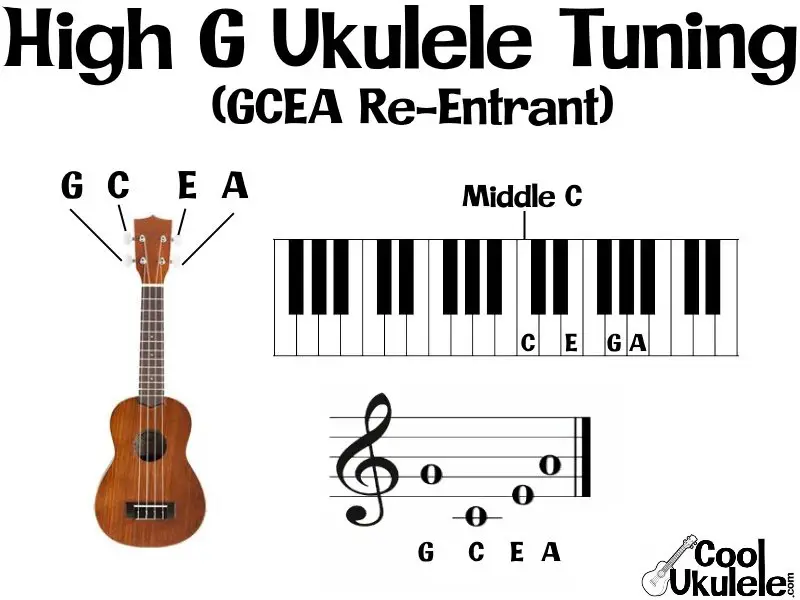
Some theorize that High-G (re-entrant) tuning was originally used because ukulele strings were historically made of animal gut; and thicker strings were excessively costly or impossible to produce.
Others theorize that its purpose was to brighten the sound of the instrument’s strumming.
Whatever the exact origin, High-G tuning became the traditional system for soprano, concert, and tenor ukuleles.
What is Low-G Ukulele Tuning?
Low G ukulele tuning basically takes the traditional G-C-E-A, High G tuning (used on soprano, concert, and tenor ukes), and lowers the G string by an octave.

The effect is a deeper, fuller sound, as well as some differences in range and playing. All of which we’ll discuss below.
Low G vs. High G Ukulele: Sound Comparison
When it comes to the sound produced by a Low-G tuned ukulele vs. a High-G tuned ukulele, the Low-G will usually have a lower, deeper, fuller, and slightly more “guitar-like” sound.
High-G tuned ukuleles, on the other hand, will have a brighter, lighter, and more quintessentially ukulele sound.
Here’s a video to demonstrate this difference:
How does a Low-G Banjo Ukulele Sound vs. a High-G?
Banjo ukuleles are generally louder, twangier and more metallic sounding than their wood-bodied counterparts.
In terms of comparing a Low-G Banjo Uke to High-G, they generally follow the same pattern as standard. Low-G will sound deeper and more guitar-like, while the High-G will sound lighter, brighter, and more stereo-typically ukulele.
Here’s a video which demonstrates this sound difference in Banjo Ukes well:
I definitely prefer High-G tuning on a Banjo ukulele, but it’s absolutely a matter of personal preference.
For more information on the actual tuning of a Banjo Ukulele, check out our Banjo Ukulele Tuning article.
How Does a Pineapple Ukulele Tuned to Low-G Compare With One Tuned To High-G?
Pineapple ukuleles are generally louder and more mellow sounding than similar standard “figure eight” shaped ukuleles. This is due to the larger body volume and front and back panels holding more air to resonate.
We’re currently working on a video which will demonstrate the sound difference between a Pineapple ukulele tuned to Low-G tuned and High-G; so be sure to check back later!
For more information on Pineapple Ukulele bodies and how they compare to the standard shape, check out our Pineapple Ukulele vs. Standard Article.
What are the Frequencies Used in High G and Low G Ukulele Tuning?
For high G ukulele tuning, the standard (equal temperament) frequencies used are as follows:
| String | Tuned Frequency |
| High G | 392 Hz |
| C | 261.63 (often rounded to 262) Hz |
| E | 329.63 (often rounder to 330) Hz |
| A | 440 Hz |
For Low G ukulele tuning, the standard (equal temperament) frequencies used are:
| String | Tuned Frequency |
| Low G | 196 Hz |
| C | 261.63 (often rounded to 262) Hz |
| E | 329.63 (often rounded to 330) Hz |
| A | 440 Hz |
What is the Range Difference Between High-G and Low-G Tuning?
A soprano, concert, or tenor ukulele with low-G tuning will have a 5-note greater overall range (extending lower) compared to an equivalent high-G tuned uke.
These 5 extra notes in your overall range can increase what you are able to play and will specifically give you more bass notes to choose from in various styles and allow you to play music in lower keys than you would otherwise be able.
Low-G Greater Range Advantage For Given Hand Position
An often-overlooked advantage to Low-G tuning is that not only do you have a greater range on the ukulele overall, you also have a greater range within any given hand position on the uke’s fret-board.
For example, let’s say you are playing with your hand positioned at the 7th fret. With High-G tuning, the lowest note you have available, without moving your hand up or down the fret-board, is G (above middle C).
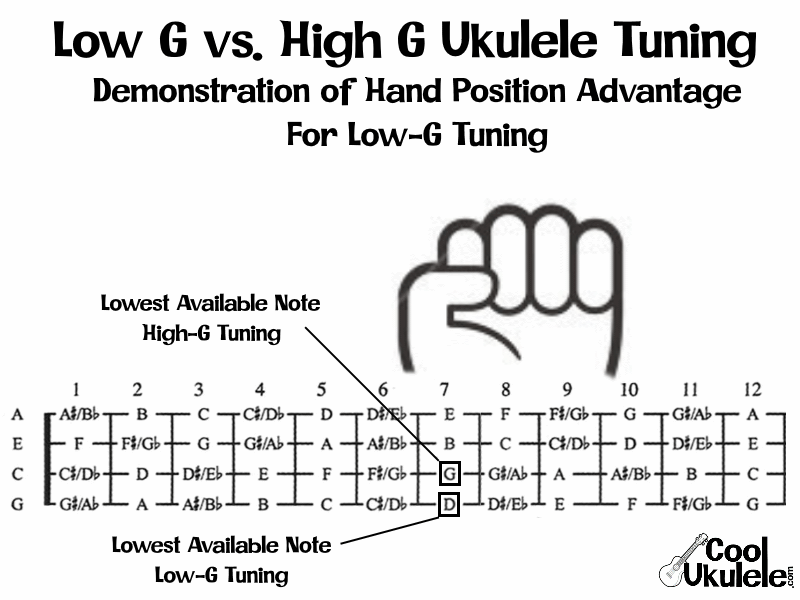
With Low G tuning you have access to D (above middle C) without moving your hand. You’d have to move your hand all the way down to the 2nd fret to play that D with High-G tuning.
That’s an additional 5 notes within the same hand-position which might not seem like that big of an advantage, but those 5 notes can come in quite “handy” when playing fast, difficult music. In some cases, this advantage could be the difference between being able to play a piece of music and not being able to play it… or being able to play it well or not well.
How Do Chord Shapes in Low G Tuning Compare to Those in High G?
Both Low G and High G ukulele tuning systems use the same chord shapes.
This is because the G string in each tuning system is an octave different from the other.
And any pitch played on a given fret will be an octave different from the other played on the same fret.
In harmony, when a pitch of a chord changes by an octave, the chord is still considered the same, though they will sound slightly different due to the different chord voicing.
But just in case you don’t believe me, I’ve added a Low G and a High G chord chart here so you can compare each identical chord shape:
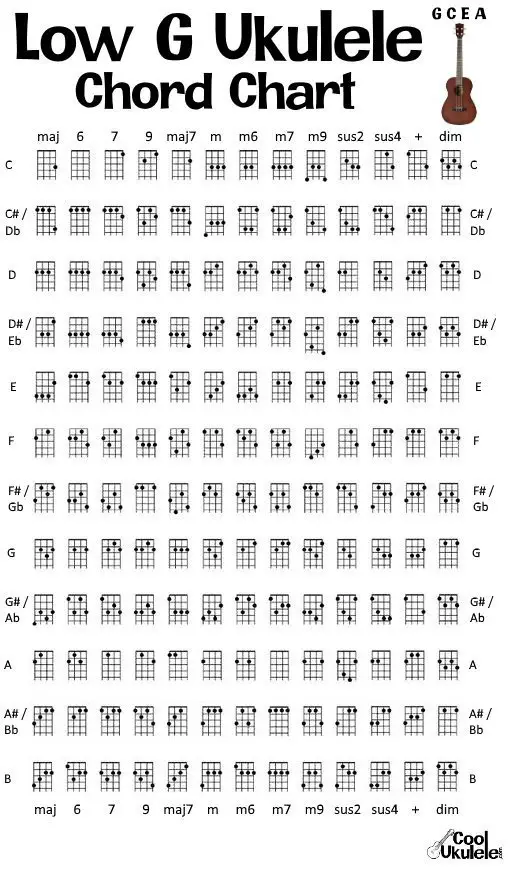
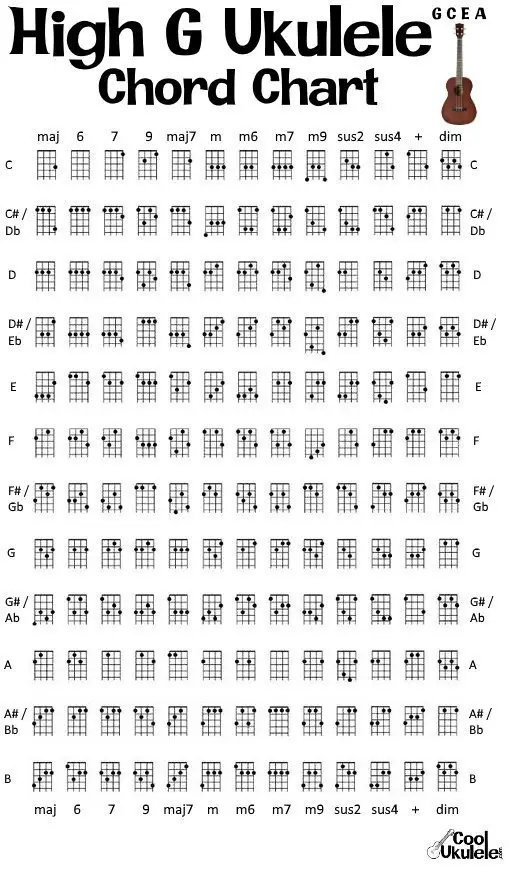
High G vs. Low G Fretboard Notes Comparison
The notes up the neck of the fretboard for high G and Low G tuning are the same, except that the Low G string’s notes are an octave lower
Here’s the High G Fingerboard Notes Chart.

And here’s the Low G version.
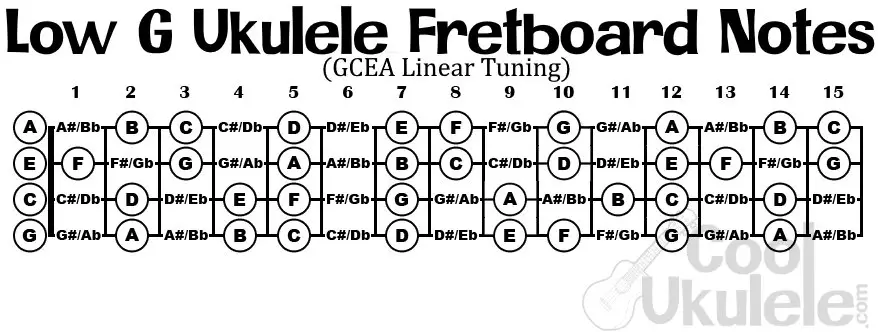
Playing Style Differences
When it comes to simple up/down strumming patterns, neither Low-G nor High-G ukulele tuning setup has much advantage over the other. It really is a matter of sound preferences.
For some styles, however, one tuning system can be preferable over the other, and a player who is looking to focus on that playing style will likely want to choose the tuning system which is more befitting that style.
Here we’ll examine some playing styles such as: basic strumming, melody playing, bass pluck and strumming, finger style, clawhammer, and advanced strumming; and we’ll look at what the advantages and disadvantages are for Low-G vs. High-G tuning for each of these styles.
Basic Strumming: Low-G vs. High G
When using basic strum patterns to play the ukulele, the Low-G or High-G tuning won’t make much difference to the actual playing of the instrument.
As there is little or no difference in playing, the advantage here defaults back to which sound you prefer for the specific piece of music you are playing.
Do you want deeper, slightly more serious, guitar-like qualities? Go with Low-G.
Do you want a bighter, more “happy”, slightly gentler, typical ukulele sound? Go with High-G.
Melodic Playing (Soloing)
When playing melodically (commonly called soloing) on ukulele, Low-G tuning has the definite advantage.
The main two advantages are the two differences discussed in the range section above.
That is, that the Low-G tuned ukulele has a greater overall range of five notes, and that it also has the five note advantage at any given hand position meaning there is less movement required to play the same notes.
Bass Pluck and Strumming Technique
An example of this style would be IZ’s “Over The Rainbow/Wonderful World” Medley. In general, it involved plucking a bass note in one of the two lower strings on the downbeat, then finishing off the pattern with some kind of up and down strumming technique.
The advantage for this style definitely goes to Low-G tuning, as you will have access to more bass notes for plucking. IZ uses Low-G tuning in his famous recording and he absolutely takes advantage of those 5 extra bass notes.
If you’re playing something where all the bass notes needed are on the C string, then the extra bass note advantage disappears and it comes back to a matter of sound preference.
Low G vs. High G for Finger Style Ukulele
Playing “Finger Style” ukulele involved playing your thumb and three or four fingers in different repeated patterns.
It often includes a “pinch” with your thumb and a finger playing two strings at the same time on a down beat, then playing a one-finger-at-a-time arrangement to finish the pattern giving an arpeggio (playing different notes of a chord in a pattern) effect. The “pinch” isn’t always used, however.
For this style, Low-G tuning also takes the advantage. Again the access to greater number of bass notes is advantageous.
Also, because the G string and A string in High-G tuning are so close together, they will often be played as unison (both playing the same note) which can sound unpleasant when played in sequence or when only these two strings are played in a “pinch”.
With Low-G tuning, these unison notes would instead be octaves (the same letter note but higher or lower) which sounds much better in these scenarios.
Clawhammer Style Ukulele
Clawhammer ukulele is an adaptation of a 5-string Banjo playing style adapted for ukulele.
The most important element of clawhammer playing is its bum-ditty rhythm which adds texture to the background of a plucked melody.
Here’s a video that shows a quick demonstration of this style.
There are ways to adapts some elements of clawhammer style to low G tuning, but to play it traditionally requires a higher top string similar to 5-string banjo.
Because of this, high G tuning must be ruled the superior system for clawhammer ukulele.
Advanced Strumming (Split Stroke, Fan Stroke, etc.)
Advanced ukulele strumming is perhaps best exemplified by George Formby on his banjo ukulele.
It basically involved playing fast strum patterns usually in syncopated rhythm which gives a stereotypical 1920’s-30’s vaudeville sound.
In my opinion, this style benefits from High-G ukulele tuning because it is such a quintessentially ukulele style that you’d want the tuning system that also gives the typical ukulele sound (High-G).
Availability of Low-G and High-G String Sets and Ukuleles
How Available are Low-G Strings Compared to High-G?
Both High G and Low G string sets are produced by all the main string makers and readily available online or at instrument shops that carry ukulele accessories.
Cost-wise, Low-G string sets are often slightly more expensive than their High-G counterparts.
This is because the Low-G string is thicker and often metal-wound and therefore more costly to produce. The difference is usually only around a dollar, so it shouldn’t make a difference if Low-G is your choice.
What is the Availability of Low-G and High-G Strings on Pre-Strung Ukuleles?
Just about all ukuleles are sold pre-strung and most pre-strung soprano, concert, and tenor ukuleles available for sale will be strung for High-G tuning.
This is great if you want to use High-G tuning because you don’t have to go through the effort and expense of replacing your strings.
It can be a bummer, however, if Low-G tuning is what you’re looking for. Some ukes are pre-strung with Low-G though so you may luck out if you search around.
Low-G vs. High-G Tuning: Conclusion
Well, there you have it. We’ve gone over the basic differences between Low-G and High-G ukulele tuning, how those differences affect the instruments sound playing in various uke playing styles, and finally topics related to availability and purchasing of Low-G and High-G String sets and Ukuleles. Let us know in the comments if we missed anything!
And remember, if you can’t decide, you could always get two ukuleles and have one tuned for Low-G and one for High-G. The best of both worlds!
Be sure to leave a comment on which tuning system you prefer and why!
The Old Low G vs. High G Ukulele Tuning Article
The following is the old article on this subject (High G vs. Low G Ukulele Tuning). I’ve tacked it onto the end of this new article in case there is something useful in it:
When it comes to the ukulele there’s an important decision to be made: should you use low-G or high-G tuning? (Alternatively low-A or high-A for D tuning). Each has its own advantages and works well in certain situations.
Advantages of High-G Ukulele
The high-G ukulele creates the close harmony chords that give the ukulele its distinctive sound. Making it perfect for chordal accompaniment.
It’s also great for single note runs. The close tuning lets you move down a scale across the strings rather than down them.
This means you can let the notes ring into each other. A style of playing that John King refers to as ‘campanella’. I love this style of playing; it creates a very pleasing, harp-like effect.
Advantages of Low-G Ukulele
Having the low-G string widens the ukulele’s range considerably.
You have a lot more bass notes to play with. If you are playing solo, instrumental pieces this can be a big advantage.
You can accompany your melodies with bass notes. It also gives chords a fuller sound.
Pro’s Choice
There’s no real consensus on tuning among the pros either. Both tunings are used. And not necessarily in the way you’d expect.
Israel Kamakawiwo’ole used low-G tuning (you can hear his low bass note followed by strums of the higher strings on his version of Over the Rainbow).
On the other hand, Jake Shimabukuro uses high-G tuning for his solo flights. Whereas James Hill most often uses the low-A tuning.
My Choice
If I had to choose one of the tunings, I’d go with the high-G. The low-G tuning feels almost like a completely different instrument to me.
You have to change your style of playing quite significantly to take full advantage of the low-G tuning. And I just love the re-entrant sound too much.

and….. you can put a tenor banjo easily in low G and ukulele tuning when you use the next steel strings: 0.020/0,016/0.012/0.008 inch (57,5 cm from fret 0 to bridge) for G3/C4/E4/A4 so you can play with your ukulele knowledge a tenor banjo 🙂
Despite the limited range, I really enjoy picking melodies and close arpeggios on reentrant (high G) tuning. You might even say there’s an advantage in playing some melodies that work nicely with alternating thumb and finger playing. I have one ukulele with a low G but I find I don’t use it often. (On my baritone, however, I prefer linear tuning.)
Full answers to all my questions. Am looking at buying a low g tenor for classical pieces. Thanks
No one has mentioned the availability of printed sheet music for the separate tunings. It seems to me that this could be an issue and I would like guidance in this reguard as I don’t have a two uke budget.
Thank you for your excellent website. I am a new ukelele player and start formal lessons in a week. Up to now I just practiced accords and notes and strums but has not gotten me far. You do an great job of explaining the whys and whats that interest me so much. I have learned more from 2 of your posts than from all the videos and other stuff I watched and read so far.